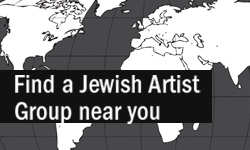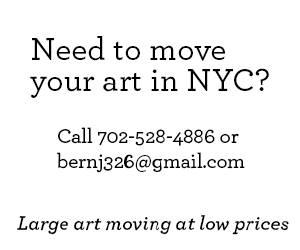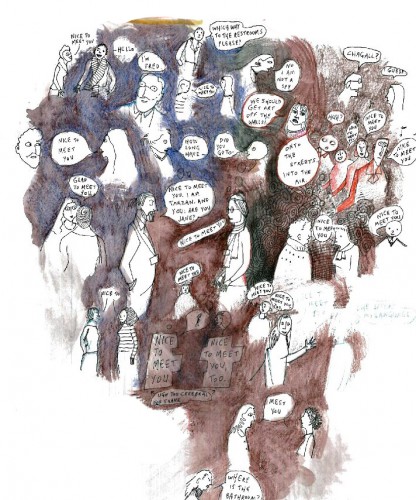Collaboration: Why You Need It (and How to Prevent Pitfalls)
13 Mar2013
Continuing coverage of the CAJM Conference in NYC
As more and more Jewish institutions are looking to innovate the way they engage, many are opening up to collaborations they would not have pursued before.
Although far-reaching partnerships and crowdsourcing are integral parts of the way an audience is cultivated in the 21st century, the resistance to collaboration by established institutions can often come from territorialism based on geographical distinctions. The mentality can sometimes be that if you are physically standing in one institution, you are therefore not standing in another. However, developments in cultural engagement have changed and more and more institutions are feeling less competitive as they design their programming to be one of many options to get an audience’s attention.
The Council of American Jewish Museums conference session “Thinking Outside the Box: Non-Traditional Collaborations, Programs, and Audiences” and the responsive discussion circles that followed led to many examples of collaborations that worked, and collaborations that despite many efforts, just did not.
We gleaned an understanding of the issues with collaboration and how to help institutions, artists, and curators, overcome these issues and work together more effectively.
What are we dealing with?
Collaborations are made when there is an exchange between content providers, venues, and community engagers. This combination can be made of organizations that cater to different audiences (ethnic, cultural, geographic) or between artists and institutions who can host their artwork and programs.
Panelist Nelly Silagy Benedek from the Jewish Museum in New York stated that partnerships only work when both sides benefit. At first glance it seems simple but finding the right match, and zeroing in on what each group needs, is the hardest part.
Problems and Solutions
Problem: Competition
Institutions are hesitant to collaborate because many organizations have the same goal. They are afraid audiences will choose one institution over another, and are afraid to lose territorial control over their audience.
Solution: Opening Up
Don’t think of your audience choosing one institution over another. People don’t eat one meal a day. Sometimes you are in the mood for spice, sometimes you want something sweet. Rather, the more programs that may be similar to one another show that there is interest in this subject, and possible opportunity for collaboration between institutions. If your pursuits align, so will your audiences.
Problem: High Risk
They are afraid of the risks involved. When an institution works with an organization or artist they have never worked with before, they do not have the assurance that it will work out to everyone’s benefit. This is a contributing factor to how artists have little access to the institutional world.
Solution: Start out small
Start out with a small partnership with low risk. Follow a start-up model and be willing to try with a small expected failure rate. Grow from there. It will benefit you in the long run.
Problem: Disconnect
Major institutions are considered impenetrable. As such, individual artists will grow and foster the exact culture the institution purports to represent outside of those walls. Artists make a tremendous sacrifice for their Jewish work but are not often supported for it and there is little in-between to bridge the gap between the institution and the individual artist.
Solution: Mediator
We say there should be a culture of curators who move between institutions and artists. Who use a sports-inspired farm system to develop and nurture. This is a long term investment that pays off tremendously for plenty of other galleries and curators in the wider art world.
Possible Steps for partnerships:
1. Find out what are the important elements of what you represent and what you offer to others. Be willing to admit areas you are lacking.
2. Utilize artists as educators first and then build programming around their work. In this case the institution already knows the person, is already paying for them to be there, and they have a knowledge of the established rhythms of the institution.
3. Use an outside curator (Jewish Art Now, anyone…?) who helps you get an objective perspective.
4. Exchange technology/tools for content or vice versa. Example: If you represent an organization trying to get the elderly online, find app builders who work on intuitive programs for non-users.
Ask yourself: Who do you want to work with, and why can’t you? This can also be asked in regards to past events, as in, “who did you want to work with, and why couldn’t you?”
Tips for Institutions:
1. Don’t take yourselves so seriously.
2. Don’t be afraid of the elements involved which might be outside of the norm for your institution (technology, interactive, approach, otherwise).
3. Debra Edelman, of the Jewish Theological Seminary Contemporary Arts Initiative stated that If you are large enough to have many facets, collaboration within the institution should be a no-brainer- these resources won’t tax your donors.
4. As Yeshiva University Museum curator Zachary Levine pointed out, “It seems that all museums can handle one day or one week installations”. Utilize a movie theater model and host limited engagements.
5. Have a permanent position for partnerships, as existing staff are often too busy.
Partnerships Between Artists and Institutions
Residencies for visual and performing arts
Benefits:
1. Artist in residence programs lead to the creation of new work, as well as involve engagement between artists and institutions, and the public.
2. Artists benefit from money, space, and time to create work.
3. As Katherine Tane of the Jewish Historical Museum said, “People come for art- not the historical context, then they enjoy the further content.”
Ideas to try:
1. Turn synagogue and non-traditional spaces into to exhibition areas (this can be done for a low cost utilizing the newest advances in hanging systems, projection, etc).
2. Turn galleries into studio space during off-seasons, include participatory element or workshop.
3. Sometimes museums invite artists in to reinterpret collections. This should not be limited to major names, as innovation usually grows from the ground up.
Considerations:
1. To incubate, projects need lots of time.
2. Artists need to be receptive to partners and public; institution needs to understand the artist’s process.
3. Residency programs require a certain type of artist who would be excited by the opportunity.
4. Define success and what that means to your institution. This can mean the outcomes in terms of numbers, successful conversations, surprises along the way, or it could be the degree of “good” work created and the spirit generated.
5. Consider hosting a group of artists in residence, to avoid the solitude of a lone resident artist.
So why bother?
If you are not creating these collaborations, both parties miss out.
*Ideas presented in this article were drawn from presenters, participants, and official CAJMcon tweets.
For more of our coverage of the 2013 CAJM conference, visit this link.
Comments are welcome!
- In: News
- Tags: Jewish Art Education, Jewish Artist Groups, Jewish Galleries, Marketing, Museums, NYC





